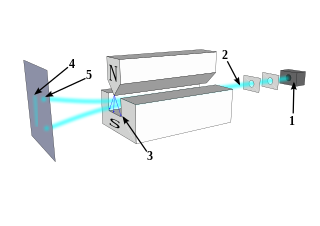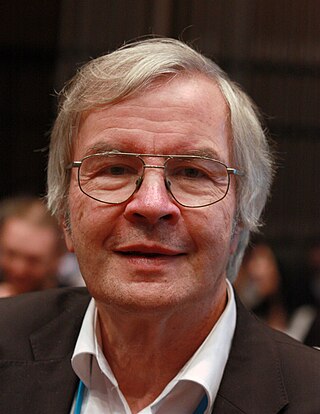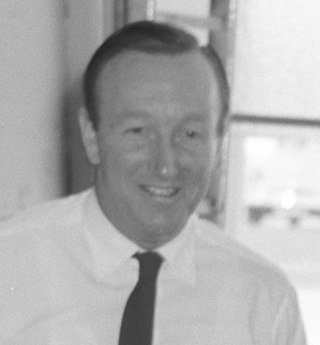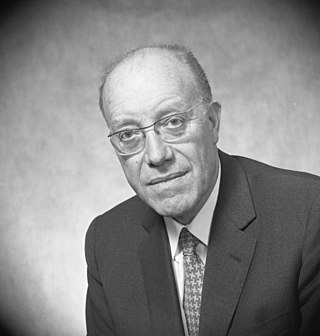Related Research Articles

The neutron is a subatomic particle, symbol
n
or
n0
, which has a neutral charge, and a mass slightly greater than that of a proton. Protons and neutrons constitute the nuclei of atoms. Since protons and neutrons behave similarly within the nucleus, and each has a mass of approximately one atomic mass unit, they are both referred to as nucleons. Their properties and interactions are described by nuclear physics. Protons and neutrons are not elementary particles; each is composed of three quarks.

Walther Wilhelm Georg Bothe was a German nuclear physicist, who shared the Nobel Prize in Physics in 1954 with Max Born.

Otto Stern was a German-American physicist and Nobel laureate in physics. He was the second most nominated person for a Nobel Prize, with 82 nominations in the years 1925–1945, ultimately winning in 1943.
Peter Armbruster is a German physicist at the Gesellschaft für Schwerionenforschung (GSI) facility in Darmstadt, Germany, and is credited with co-discovering elements 107 (bohrium), 108 (hassium), 109 (meitnerium), 110 (darmstadtium), 111 (roentgenium), and 112 (copernicium) with research partner Gottfried Münzenberg.

The Stern–Gerlach experiment demonstrated that the spatial orientation of angular momentum is quantized. Thus an atomic-scale system was shown to have intrinsically quantum properties. In the original experiment, silver atoms were sent through a spatially varying magnetic field, which deflected them before they struck a detector screen, such as a glass slide. Particles with non-zero magnetic moment are deflected, due to the magnetic field gradient, from a straight path. The screen reveals discrete points of accumulation, rather than a continuous distribution, owing to their quantized spin. Historically, this experiment was decisive in convincing physicists of the reality of angular-momentum quantization in all atomic-scale systems.

The names Uranverein or Uranprojekt came to be applied in Nazi Germany to research into nuclear technology - including nuclear weapons and nuclear reactors - before and during World War II. Development took place in several phases, but in the words of historian Mark Walker, it ultimately became "frozen at the laboratory level" with the "modest goal" to "build a nuclear reactor which could sustain a nuclear fission chain reaction for a significant amount of time and to achieve the complete separation of at least tiny amount of the uranium isotopes". The scholarly consensus is that it failed to achieve these goals, and that despite fears at the time, the Germans had never been close to producing nuclear weapons.
Jan Peter Toennies is an American scientist and former director of the Max Planck Institute for Dynamics and Self-Organization.

Theodor Wolfgang Hänsch is a German physicist. He received one-third of the 2005 Nobel Prize in Physics for "contributions to the development of laser-based precision spectroscopy, including the optical frequency comb technique", sharing the prize with John L. Hall and Roy J. Glauber.
The Faculty of Physics and Astronomy is one of twelve faculties at the University of Heidelberg. It comprises the Kirchhoff Institute of Physics, the Institute of Physics, Theoretical Physics, Environmental Physics and Theoretical Astrophysics.
The Stern–Gerlach Medal is the most prestigious German Award for experimental physicists, named after the scientists of the Stern–Gerlach experiment, Otto Stern and Walther Gerlach.
Wolfgang Gentner was a German experimental nuclear physicist.
Georg Carl Stetter was an Austrian-German nuclear physicist. Stetter was Director of the Second Physics Institute of the University of Vienna. He was a principal member of the German nuclear energy project, also known as the Uranium Club. In the latter years of World War II, he was also the Director of the Institute for Neutron Research. After the war, he was dismissed from his university positions, and he then became involved in dust protection research. After his dismissal was overturned, he became Director of the First Physics Institute of the University of Vienna, and he began research on aerosols. In 1962, Stetter became a full Member of the Austrian Academy of Sciences. In that same year, the Academy established their Commission for Clean Air, and Stetter served as its chairman until 1985.
Gottfried Freiherr von Droste (1908–1992), a.k.a. Gottfried Freiherr von Droste zu Vischering-Padberg, was a German physical chemist. He worked at the Kaiser Wilhelm Institute for Chemistry (KWIC). He independently predicted that nuclear fission would release a large amount of energy. During World War II, he participated in the German nuclear energy project, also known as the Uranverein. In the latter years of the war, he worked at the Reich’s University of Strassburg. After the war, he worked at the Physikalisch-Technische Bundesanstalt (Federal Physical and Technical Institute and also held a position at the Technical University of Braunschweig.

Francis James Macdonald Farley FRS was a British scientist. He was elected Fellow of the Royal Society on 16 March 1972 earning the designation FRS. He was also a Fellow of the Institute of Physics and an honorary fellow of Trinity College Dublin. He was educated at Clifton College and at Clare College, Cambridge. Farley obtained his PhD from Cambridge in 1950.

Heinz Maier-Leibnitz was a German physicist. He made contributions to nuclear spectroscopy, coincidence measurement techniques, radioactive tracers for biochemistry and medicine, and neutron optics. He was an influential educator and an advisor to the Federal Republic of Germany on nuclear programs.

Jürgen Jost is a German mathematician specializing in geometry. He has been a director of the Max Planck Institute for Mathematics in the Sciences in Leipzig since 1996.

Valery Anatolyevich Rubakov was a Russian theoretical physicist. His scientific interests included quantum field theory, elementary particle physics, and cosmology. He was affiliated with the Institute for Nuclear Research (INR) of the Russian Academy of Sciences in Moscow.

Johanna Barbara Stachel is a German nuclear physicist. She is a professor in experimental physics at the University of Heidelberg. Stachel is a former president of the German Physical Society (DPG).
Christian Alfred Elie Janot was a French physicist and materials scientist known for his work on materials characterization using Mössbauer spectroscopy and his physical metallurgy studies of quasicrystals and noncrystalline materials using neutron scattering techniques.
The nucleon magnetic moments are the intrinsic magnetic dipole moments of the proton and neutron, symbols μp and μn. The nucleus of an atom comprises protons and neutrons, both nucleons that behave as small magnets. Their magnetic strengths are measured by their magnetic moments. The nucleons interact with normal matter through either the nuclear force or their magnetic moments, with the charged proton also interacting by the Coulomb force.
References
- ↑ Kürschner's Deutscher Gelehrtenkalender, 2006, Vol. 1, p. 765, ISBN 978-3-598-23629-7
- ↑ "Preisträger Stern-Gerlach nach Jahren". Archived from the original on 2014-02-23. Retrieved 2014-04-16.
- ↑ "News | TU Wien".